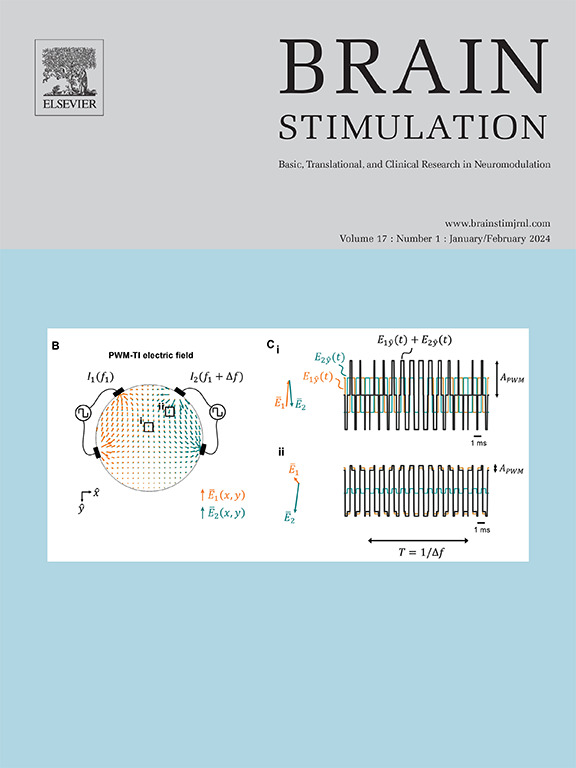脑深部刺激可减轻啮齿类动物脑外伤模型的记忆缺陷。
IF 8.4
1区 医学
Q1 CLINICAL NEUROLOGY
引用次数: 0
摘要
背景:创伤性脑损伤(TBI)是威胁生命的重大事件。除了神经功能缺损外,它还会导致注意力和记忆力的长期损伤。脑深部刺激(DBS)是一种治疗运动障碍的成熟疗法,最近已被研究用于改善各种障碍的记忆力。在创伤性脑损伤模型中,对啮齿类动物在受伤后很长时间内进行不同脑靶点的刺激,目的是治疗运动障碍、协调和记忆损伤:试验假设:在创伤性脑损伤后不久对大鼠进行脑刺激电刺激可防止记忆障碍的发展并发挥神经保护作用:方法:雄性大鼠在侧脑液叩击伤(FPI)一周前在丘脑前核(ANT)植入 DBS 电极。四天后,对动物进行新物体/新位置识别测试(NOR/NLR)和巴恩斯迷宫范式评估。实验结束后,对海马细胞进行计数。在创伤性脑损伤后的不同时间点分别处死几组动物,以测定细胞因子和脑源性神经营养因子(BDNF)。在第二组实验中,向接受主动或假刺激的创伤性脑损伤动物注射肌球蛋白受体激酶 B(TrkB)拮抗剂 ANA-12,然后进行行为测试:结果:与假DBS TBI动物或非植入对照组相比,接受DBS刺激的TBI大鼠在巴恩斯迷宫中的几个变量有所改善,但在NOR/NLR方面没有明显改善。接受刺激的动物的 BDNF 水平以及海枕部、CA3 和 CA1 区域的海马细胞数量均有显著增加。DBS未能使创伤性脑损伤动物周围皮层和海马中增加的TNFα和促炎细胞因子IL1β水平恢复正常。药理实验表明,在使用 DBS 的同时使用 ANA-12 并不能抵消 ANT 刺激动物的记忆改善效果:结论:创伤性脑损伤后立即给予 DBS 可减轻大鼠的记忆缺陷,增加 BDNF 的表达和海马细胞的数量。这些作用的机制与抗炎作用或通过 TrkB 受体介导无关。本文章由计算机程序翻译,如有差异,请以英文原文为准。
Deep brain stimulation mitigates memory deficits in a rodent model of traumatic brain injury
Background
Traumatic brain injury (TBI) is a major life-threatening event. In addition to neurological deficits, it can lead to long-term impairments in attention and memory. Deep brain stimulation (DBS) is an established therapy for movement disorders that has been recently investigated for memory improvement in various disorders. In models of TBI, stimulation delivered to different brain targets has been administered to rodents long after the injury with the objective of treating motor deficits, coordination and memory impairment.
Objective
To test the hypothesis that DBS administered soon after TBI may prevent the development of memory deficits and exert neuroprotective effects.
Methods
Male rats were implanted with DBS electrodes in the anterior nucleus of the thalamus (ANT) one week prior to lateral fluid percussion injury (FPI). Immediately after TBI, animals received active or sham stimulation for 6 h. Four days later, they were assessed in a novel object/novel location recognition test (NOR/NLR) and a Barnes maze paradigm. After the experiments, hippocampal cells were counted. Separate groups of animals were sacrificed at different timepoints after TBI to measure cytokines and brain derived neurotrophic factor (BDNF). In a second set of experiments, TBI-exposed animals receiving active or sham stimulation were injected with the tropomyosin receptor kinase B (TrkB) antagonist ANA-12, followed by behavioural testing.
Results
Rats exposed to TBI given DBS had an improvement in several variables of the Barnes maze, but no significant improvements in NOR/NLR compared to Sham DBS TBI animals or non-implanted controls. Animals receiving stimulation had a significant increase in BDNF levels, as well as in hippocampal cell counts in the hilus, CA3 and CA1 regions. DBS failed to normalize the increased levels of TNFα and the proinflammatory cytokine IL1β in the perilesional cortex and the hippocampus of the TBI-exposed animals. Pharmacological experiments revealed that ANA-12 administered alongside DBS did not counter the memory improvement observed in ANT stimulated animals.
Conclusions
DBS delivered immediately after TBI mitigated memory deficits, increased the expression of BDNF and the number of hippocampal cells in rats. Mechanisms for these effects were not related to an anti-inflammatory effect or mediated via TrkB receptors.
求助全文
通过发布文献求助,成功后即可免费获取论文全文。
去求助
来源期刊

Brain Stimulation
医学-临床神经学
CiteScore
13.10
自引率
9.10%
发文量
256
审稿时长
72 days
期刊介绍:
Brain Stimulation publishes on the entire field of brain stimulation, including noninvasive and invasive techniques and technologies that alter brain function through the use of electrical, magnetic, radiowave, or focally targeted pharmacologic stimulation.
Brain Stimulation aims to be the premier journal for publication of original research in the field of neuromodulation. The journal includes: a) Original articles; b) Short Communications; c) Invited and original reviews; d) Technology and methodological perspectives (reviews of new devices, description of new methods, etc.); and e) Letters to the Editor. Special issues of the journal will be considered based on scientific merit.
 求助内容:
求助内容: 应助结果提醒方式:
应助结果提醒方式:


